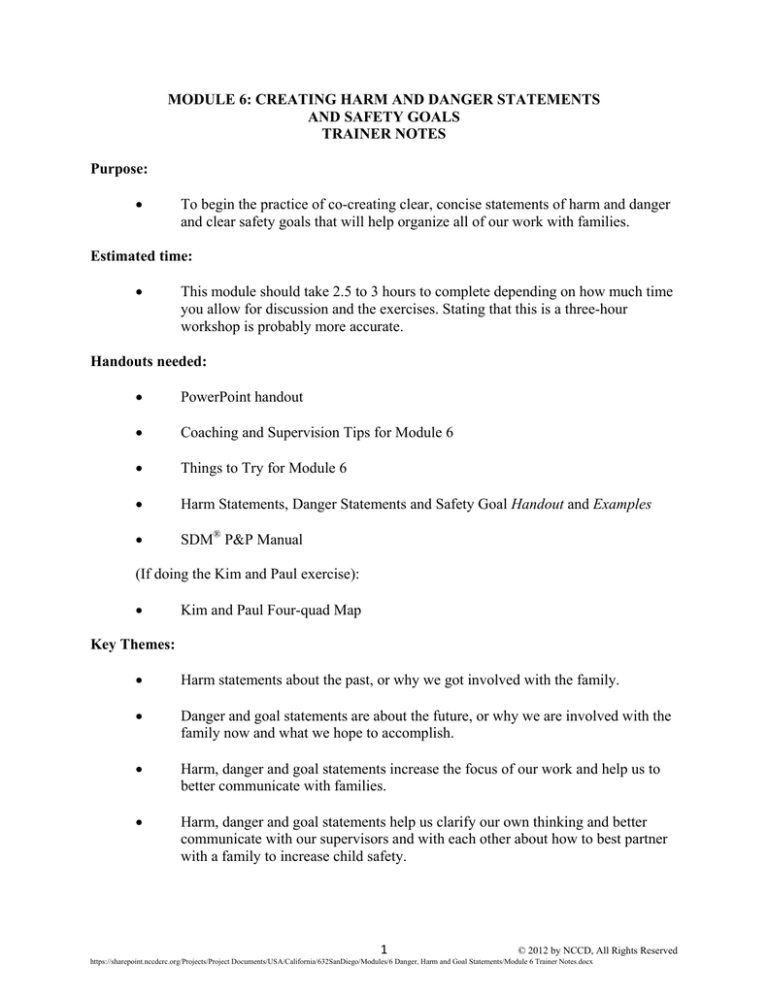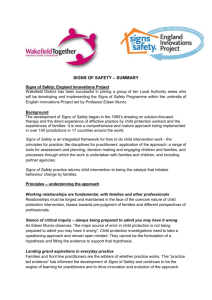
MODULE 6: CREATING HARM AND DANGER STATEMENTS
AND SAFETY GOALS
TRAINER NOTES
Purpose:
To begin the practice of co-creating clear, concise statements of harm and danger
and clear safety goals that will help organize all of our work with families.
Estimated time:
This module should take 2.5 to 3 hours to complete depending on how much time
you allow for discussion and the exercises. Stating that this is a three-hour
workshop is probably more accurate.
Handouts needed:
PowerPoint handout
Coaching and Supervision Tips for Module 6
Things to Try for Module 6
Harm Statements, Danger Statements and Safety Goal Handout and Examples
SDM® P&P Manual
(If doing the Kim and Paul exercise):
Kim and Paul Four-quad Map
Key Themes:
Harm statements about the past, or why we got involved with the family.
Danger and goal statements are about the future, or why we are involved with the
family now and what we hope to accomplish.
Harm, danger and goal statements increase the focus of our work and help us to
better communicate with families.
Harm, danger and goal statements help us clarify our own thinking and better
communicate with our supervisors and with each other about how to best partner
with a family to increase child safety.
1
© 2012 by NCCD, All Rights Reserved
https://sharepoint.nccdcrc.org/Projects/Project Documents/USA/California/632SanDiego/Modules/6 Danger, Harm and Goal Statements/Module 6 Trainer Notes.docx
Whenever possible it is best practice to craft these statements WITH families but
critically important to remember not to give up agency “bottom lines” when
creating them.
The SDM System helps to focus on what needs to be addressed in the harm,
danger and goal statements. Safety threats from the SDM safety assessment
should correspond directly with concerns mentioned in the Danger Statements.
Safety goals are clear, simple statements about what the caregiver will DO that
will convince everyone the child is safe now and into the future.
Instructions:
See trainer notes in the PowerPoint presentation. Also, see below for trainer notes on exercises.
Exercises:
1) “Let’s Get Started” exercise (Slides 10–11): These two slides set the table for the module by
asking the group to consider how able they are to share with families why they are working with
them (harm and danger statements) and what needs to happen for their cases to close (safety
goals). This discussion can be referred back to throughout the rest of the module. See detailed
instructions in the speaker notes of the PPT.
2) Initial Practice with all three statements:
2a) Harm Statement Practice (Slide 22)
2b) Danger Statement Practice (Slide 31)
2c) Safety Goal Practice (Slide 47)
These three little “mini” exercises with the “Wendy and Beth” vignette take place throughout the
didactic presentation on the HS, DS and SG’s. They help to break up the presentation and make
sure that everyone has had some chance to work on the statements with a relatively easy
example. See the PPT speaker notes for more details and for examples of finished statements for
each of these areas.
3) Larger Practice
Before the module concludes it is important to give the group a chance to practice on a larger or
more complicated example. Trainers have two choices at this point. They can use the Kim and
Paul example (slides 68–76) or have the group break into small groups to use their own cases
(slide 78). CRC recommends that if this is a new group to use the Kim and Paul exercise, and if
this is a group that has some practice making HS, DS and SG”s to use their own cases.
3a) Kim and Paul Harm Statements, Danger Statements and Safety Goals Practice Exercise
(Slides 68–76). 10 to 15 minutes for this exercise in the groups with time to share as the group
after.
2
© 2012 by NCCD, All Rights Reserved
https://sharepoint.nccdcrc.org/Projects/Project Documents/USA/California/632SanDiego/Modules/6 Danger, Harm and Goal Statements/Module 6 Trainer Notes.docx
This exercise asks the group to compose a danger statement for Kim and Paul. Finished product
examples of these appear in slides. These slides can be hidden in the PowerPoint and not printed
in the handouts if the trainer desires. Alternatively trainers can just ask groups to refrain from
looking ahead before they do the exercise. They can be unhidden before showing the PowerPoint
so the group can see some examples after they try to make a danger statement.
TRAINER NOTE ON THIS EXERCISE: As mentioned in the speaker notes, the safety goal for
Kim and Paul can be a provocative one and lead to a good conversation in the group. Trainers
should consider allowing the conversation to go and let the group wrestle with the difficult
dilemma of what exactly is an appropriate child welfare goal for Kim – is it sobriety or
something else? You can remind your group that you have an agreement to “agree to disagree”
your purpose is not to seek consensus on this but to deepen their conversation and invite people
to challenge their assumptions. Even if people in the group disagree greatly from each other your
trainees may learn a lot from the conversation!
Some questions to consider asking to help the conversation move along are:
What, if anything, concerns them about this safety goal for Kim?
What do they like? What concerns them?
Is sobriety always the right goal for our work?
Are there times when sobriety might be a “set-up” in our work? For CPS? For
Kim? For Paul?
How might presenting this statement open up a conversation with Kim? What
might that conversation be like?
(To the people who are concerned): Would this be different at all if Kim abused
alcohol instead of heroin? Why?
TEACHING POINT: Useful just to bring home the point…while some people may strongly feel
strongly that Kim should be sober…sobriety may not always be an appropriate goal in all our
cases where there is substance use and abuse.
3b) Open Practice (Slide 78) alternative exercise to Kim and Paul vignette
Ask one person to think of a family they are working with and know reasonably well, and for
whom there is at least one SDM safety threat. When one person in each group indicates that
he/she has a family in mind, ask that person to tell the other two the minimum they need to know
about the family. Give them three minutes ONLY, so they have to be concise. They should
include a brief genogram (who lives in the house and any known safety network members), what
information was in the initial report, which SDM safety threat exists now and brief facts that
support those safety threats.
3
© 2012 by NCCD, All Rights Reserved
https://sharepoint.nccdcrc.org/Projects/Project Documents/USA/California/632SanDiego/Modules/6 Danger, Harm and Goal Statements/Module 6 Trainer Notes.docx
They should try constructing a harm statement, danger statement and safety goal based on
these facts.
Report out by having one group volunteer to read their statements. Ask the rest of the group to
check to see how well their statements conform with the formulas and tips we’ve covered. If you
have time, you can have another group do this as well. Ask anyone who did not read theirs out
loud to take one more minute to look at theirs and wonder what the large group WOULD have
said about theirs. (Any group that presented can use this minute to tighten their statements based
on feedback.)
4) Conclude with “thinking and ahead” and show tip sheets.
4
© 2012 by NCCD, All Rights Reserved
https://sharepoint.nccdcrc.org/Projects/Project Documents/USA/California/632SanDiego/Modules/6 Danger, Harm and Goal Statements/Module 6 Trainer Notes.docx


